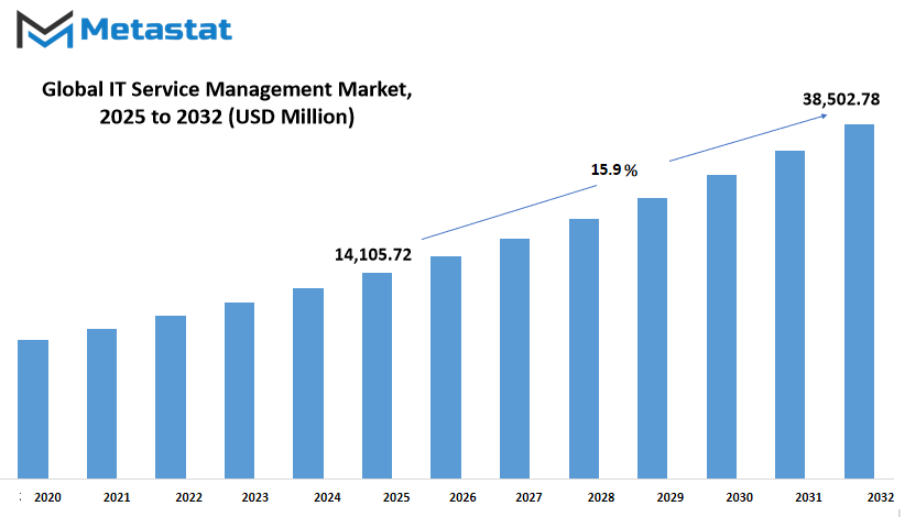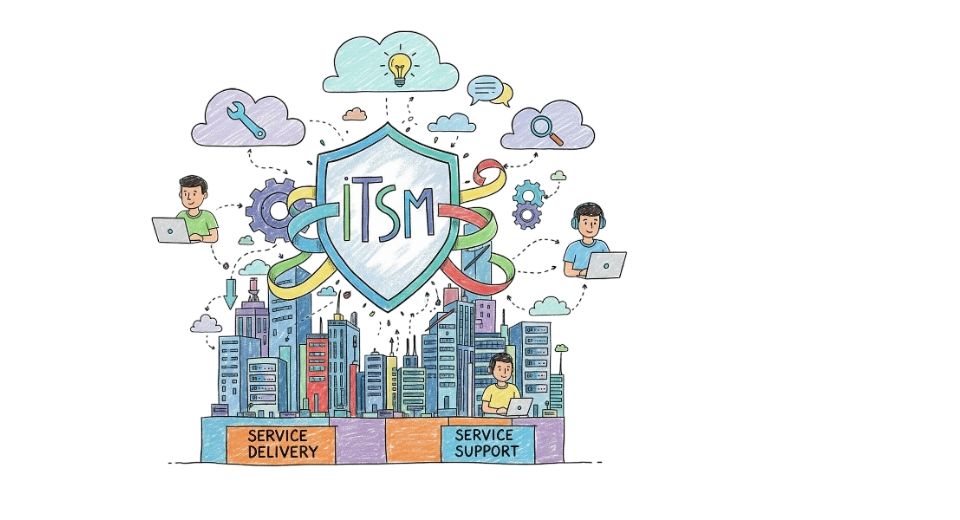MARKET OVERVIEW
The global IT service management market still defines how organizations manage technology operations on a massive scale. With businesses growing and digital infrastructure getting increasingly complex, this market will be the backbone in running processes, ensuring service delivery, and aligning technology with organizational requirements. Whereas attention is usually given to the tools and platforms, the actual power of this business will be in how it simplifies operations and achieves consistency across distributed teams and networks. In the future, the global market will not only enable traditional service desk functionality but will also expand to cover areas encompassing hybrid and multi-cloud environments. Businesses will require more structured methodologies for managing workflows, measuring performance, and ensuring that end-users get quality support regardless of the platform. In doing so, organizations prevent unnecessary downtime, eliminate costs related to inefficiencies, and establish a better balance between technology and business results.
Another factor that will shape the future of this sector is the move from reactive problem solving to proactive service improvement. Instead of fixing problems after they happen, organizations will be embracing approaches that forecast disruptions and prevent them before they become bigger problems. This transformation will drive the global IT service management market in the direction of solutions that combine automation, analytics, and integration with new systems. The capacity to predict issues and resolve them rapidly will enable firms to develop seamless technology experiences for their employees as well as customers. In addition, the global market will remain impacted by scalability demands. As digital transformation continues to grow in both private and public sectors, businesses will look for models with which demand can scale.
Whether it is handling service requests from tiny teams or managing thousands of users spread across different regions, the business will provide flexible frameworks that keep quality intact without compromising on speed. The scalability will help organizations remain competitive and able to adapt to sudden changes in demand. The governance and compliance role will also become more significant in defining the global market. As global data regulations change across borders, businesses will rely on well-organized service management to guarantee that operations adhere to legal and security requirements. Noncompliance would risk exposing organizations to financial and image risks, which would mean that the industry offers not just efficiency at operations but also a protection for long-term stability. In the future, the Global IT Service Management space will expand to an arena where relationships between people, processes, and technology are seamless. It will no longer be viewed as a behind-the-scenes function but as a core driver that determines the way companies engage with their own technological environments. As it moves in this direction, the sector will be a determining factor in making sure that organizations are resilient, adaptive, and prepared for the technological burdens of the future.
Global IT service management market is estimated to reach $38,502.78 Million by 2032; growing at a CAGR of 15.9% from 2025 to 2032.

GROWTH FACTORS
The global IT service management market is headed for robust growth, driven by swift digitalization across sectors and rising demand for effective management of IT resources. Organizations are in search of ways to streamline operations, contain costs, and provide better customer experiences, which will continue to drive adoption. Growth drivers like the growing adoption of cloud-based solutions and the trend towards automation are contributing to the market in a big way. Cloud platforms enable firms to scale services with ease and react more quickly to changes, while automation lessens the need for manual labor and increases efficiency, smoothing and making processes more reliable. These are likely to continue as main driving forces in growing the market in the future.
The increasing requirement for improved compliance and security management is another primary growth driver. With more stringent data protection laws and increasing cyber attacks, organizations are being forced to fortify systems without compromising on smooth operations. The global market is offering solutions that enable improved monitoring, reporting, and compliance, helping it attract investments. Moreover, the increasing need for analytics is also forcing organizations to implement smarter IT service management platforms. Predictive knowledge obtained through analytics enables anticipating problems prior to their interference in operations, thereby providing for improved continuity and customer satisfaction.
Still, some of the challenges would hinder growth. The high cost of implementation is still a pressing issue, particularly for small businesses that could be hamstrung by budget constraints. The other challenge is the limited number of professionals who can operate and optimize these sophisticated systems. Without professional expertise, businesses may not have the capacity to leverage the solutions to the best effect, thus resulting in slower uptake. These issues could stifle the rate of market growth if not dealt with adequately.
Despite these challenges, the global market has significant prospects over the next few years. Increasing use of artificial intelligence and machine learning in IT service platforms will unlock new avenues for efficiency and innovation. AI-driven solutions can anticipate problems, make recommendations, and even automate decision-making, enhancing performance and minimizing downtime. The growth in digital business models and the increasing emphasis on remote work will also drive demand higher, as organizations require more agile and scalable IT service systems to sustain hybrid environments.
Overall, the global IT service management market is poised for consistent growth driven by cloud adoption, automation, compliance requirements, and future-proof technologies. In spite of cost factors and talent gaps, opportunities generated due to AI, analytics, and digital transformation will guarantee robust growth in the future.
MARKET SEGMENTATION
By Deployment Mode
The global IT service management market is moving toward a future shaped by constant demand for efficiency, flexibility, and innovation. Businesses across industries are relying on streamlined solutions to manage growing technology needs, and this is pushing the market to expand at a steady pace. The ability to improve workflows, reduce downtime, and provide reliable customer support has turned IT service management into a core element of modern business strategies. As organizations adapt to digital transformation, this market will not only support current demands but also pave the way for long-term growth.
One major factor driving development in the global market is the choice of deployment mode. By Deployment Mode, the market is further segmented into On Premise and Cloud Based solutions. On Premise models are still relevant for companies that prioritize control, data privacy, and customized configurations. These solutions often appeal to organizations with strict regulatory requirements or industries where sensitive information must remain within dedicated infrastructure. While the cost of maintaining servers and hardware may be higher, On Premise deployment provides businesses with complete oversight of their systems.
On the other hand, Cloud Based solutions are becoming the preferred choice for many organizations due to scalability, cost efficiency, and easy accessibility. Cloud platforms reduce the burden of infrastructure maintenance, allowing companies to allocate resources toward innovation rather than hardware management. This model also supports remote work and global collaboration, making it a practical choice for enterprises seeking flexibility. The shift toward cloud adoption is expected to accelerate in the coming years, particularly as security and compliance standards continue to improve.
The future of the global market will reflect a balance between these two approaches. Hybrid strategies, combining both On Premise and Cloud Based systems, may rise in popularity as businesses look for ways to tailor IT operations to their specific needs. Advanced automation, artificial intelligence, and predictive analytics will further shape the direction of the market, allowing organizations to identify issues before they disrupt operations. Such innovations will not only enhance efficiency but also set higher standards for service quality and reliability.
Ultimately, the global IT service management market will continue to evolve as businesses prioritize adaptability and digital resilience. Deployment modes will remain a central factor, and the ongoing shift toward Cloud Based systems will create new opportunities while preserving the relevance of On Premise solutions. With growing reliance on technology across every sector, this market will play a critical role in supporting business continuity and shaping the future of IT infrastructure.
By Service Type
The global IT service management market will continue to gain importance as businesses worldwide depend more heavily on digital solutions to maintain smooth operations. As technology expands, organizations will require systems that can ensure reliability, efficiency, and security. The global market will play a vital role in helping companies adapt to rapid technological changes while meeting customer expectations. The ability to manage technology-driven services effectively will determine how well businesses perform in highly competitive environments.
Future growth of the global market will be influenced by advancements in artificial intelligence, automation, and cloud computing. These innovations will allow faster responses to technical issues, reducing downtime and improving customer satisfaction. For instance, automated systems will detect and resolve potential problems before they escalate, giving organizations the ability to maintain uninterrupted services. Cloud-based solutions will also make management tools more flexible and scalable, ensuring that both small enterprises and large corporations can benefit.
By service type, the global market is divided into Incident Management, Problem Management, Change Management, Service Request Management, and Configuration Management. Each segment will serve as a building block in creating stronger technology frameworks for businesses. Incident Management will focus on restoring normal service as quickly as possible when unexpected disruptions occur. Problem Management will aim at identifying recurring issues and preventing them from happening again, ultimately reducing risks. Change Management will guide organizations through safe transitions when new technology or processes are introduced. Service Request Management will handle everyday requests, ensuring quick responses to maintain customer trust. Configuration Management will provide a clear view of system components, helping companies monitor assets and reduce inefficiencies.
Looking ahead, the global market will not only enhance operational reliability but also open new opportunities for innovation. Companies will use predictive analytics to anticipate service disruptions and design proactive strategies. Digital transformation across industries will push the demand for more advanced solutions, encouraging constant improvements in service management practices. With the rise of remote work and global collaboration, maintaining consistent and secure technology services will be a top priority.
In the future, the global IT service management market will serve as a foundation for digital growth across every industry. It will shape how businesses interact with technology, ensuring that complex systems work seamlessly in the background while allowing organizations to focus on innovation, customer satisfaction, and long-term success.
By Organization Size
The global IT service management market will continue to stand as one of the most important areas in shaping the future of digital operations. Organizations across different industries are moving steadily toward advanced technology adoption, and this shift will demand stronger frameworks for managing IT services. As reliance on digital platforms increases, the global market will play a vital role in ensuring efficiency, security, and seamless service delivery. Businesses will continue to focus on solutions that reduce downtime, enhance productivity, and improve customer satisfaction.
By organization size, the global market will be divided into Small and Medium Enterprises and Large Enterprises. Each group will drive demand differently, but together they will push the market toward continuous growth. Small and Medium Enterprises will seek affordable, flexible, and scalable IT service management solutions to stay competitive against larger players. These enterprises will turn to cloud-based platforms that reduce infrastructure costs while offering reliable performance. The growing need for automation in handling routine tasks will also push adoption, as smaller organizations aim to reduce pressure on limited IT teams.
Large Enterprises will continue to shape another side of the global market. With wider operations, multiple departments, and global networks, large-scale businesses will invest in advanced platforms that provide deep visibility and stronger integration across complex systems. The demand for predictive analytics, artificial intelligence, and machine learning in service management will expand, as enterprises look for solutions that anticipate issues before they affect operations. Data-driven decision-making will become a standard, and large organizations will allocate significant resources to strengthen both security and compliance while also boosting service quality.
Looking ahead, the global market will not only respond to the present needs of organizations but also prepare for challenges that come with emerging technologies. As businesses adopt hybrid work models, the importance of reliable IT support will rise, creating opportunities for innovative solutions that manage distributed teams and remote operations. Sustainability will also influence the market, with organizations seeking IT service management platforms that support energy efficiency and green technology practices.
Overall, the global IT service management market will keep evolving as both Small and Medium Enterprises and Large Enterprises demand solutions tailored to their specific scale and complexity. The future will highlight the importance of seamless IT operations as a foundation for growth, innovation, and resilience in an increasingly digital world.
By End Use Industry
The global IT service management market is steadily moving toward a future shaped by digital growth, automation, and innovation. As technology becomes central to business operations, the demand for efficient service management tools will continue to rise. Organizations will not only rely on IT services to resolve technical problems but also to deliver seamless user experiences, improve productivity, and maintain competitive advantages. The global market will serve as a foundation for businesses aiming to integrate digital systems, streamline processes, and create more responsive networks that support both internal operations and customer-facing services.
By end use industry, the global market is divided into IT and Telecom, BFSI, Healthcare, Retail and Consumer Goods, Government, and Other. The IT and Telecom sector will remain a major driver due to increasing reliance on high-speed networks, cloud adoption, and the expansion of 5G infrastructure. The BFSI industry will also push growth, as financial institutions will depend on IT service management to secure sensitive data, prevent disruptions, and meet compliance requirements. In the healthcare sector, the adoption of IT service management will accelerate with the rise of telemedicine, digital health records, and advanced diagnostic tools, making reliable service delivery essential for patient care.
Retail and Consumer Goods will expand their use of IT service management systems as digital platforms, online shopping, and supply chain tracking become standard. In this sector, efficiency and customer satisfaction will remain at the center, with IT service management supporting smoother operations and faster response times. Government organizations will also strengthen their role in the global market, driven by the need for secure digital services, citizen data management, and transparent administration. The category marked as Other will include industries that are gradually recognizing the benefits of integrating IT service management to improve efficiency, cut costs, and prepare for a technology-driven future.
Looking ahead, automation, artificial intelligence, and cloud-based platforms will dominate the global market. Service providers will design systems that predict issues before they occur, allowing organizations to maintain continuity without interruption. Greater focus will be placed on analytics to gain insights from service data, helping decision-makers shape strategies with accuracy and speed. As businesses expand globally, IT service management will act as the backbone for managing complex infrastructures across multiple locations. The global IT service management market will not only address today’s requirements but will continue evolving to meet the challenges of tomorrow’s digital economy.
|
Forecast Period |
2025-2032 |
|
Market Size in 2025 |
$14,105.72 million |
|
Market Size by 2032 |
$38,502.78 Million |
|
Growth Rate from 2025 to 2032 |
15.9% |
|
Base Year |
2024 |
|
Regions Covered |
North America, Europe, Asia-Pacific Green, South America, Middle East & Africa |
REGIONAL ANALYSIS
The global IT service management market is set to experience significant transformation as businesses continue to adopt advanced technologies and emphasize operational efficiency. Demand for automated processes, cloud integration, and real-time monitoring will drive the expansion of IT service solutions across industries. As organizations aim to optimize workflows and reduce downtime, investments in IT service management platforms will increase, creating opportunities for both established providers and emerging companies. The focus will shift toward predictive analytics, artificial intelligence, and machine learning to improve incident management, streamline service delivery, and enhance user experience.
Based on geography, the global market is divided into North America, Europe, Asia-Pacific, South America, and Middle East & Africa. North America will maintain a leading position due to high technological adoption and substantial IT infrastructure investments. The U.S., Canada, and Mexico will play crucial roles, with the U.S. emerging as the largest contributor because of widespread cloud services adoption and robust enterprise IT strategies. Europe is expected to witness steady growth, driven by the UK, Germany, France, and Italy. Companies in these regions will increasingly focus on integrating AI-driven solutions to improve efficiency and reduce operational costs, while the rest of Europe will follow a similar trajectory, adopting IT service management platforms to support digital transformation initiatives.
The Asia-Pacific region will emerge as a highly dynamic segment of the global IT service management market. Countries such as India, China, Japan, and South Korea will drive growth as businesses modernize infrastructure and embrace cloud-based service management solutions. Rising demand for automation, coupled with government support for digital initiatives, will ensure rapid adoption in the region. The rest of Asia-Pacific will witness gradual growth as smaller economies invest in IT infrastructure to remain competitive on a global scale. South America, including Brazil, Argentina, and other countries, will experience moderate expansion. Enterprises will increasingly recognize the benefits of IT service management tools in enhancing service quality and operational visibility.
The Middle East & Africa will present emerging opportunities for the global IT service management market. GCC countries, Egypt, and South Africa will lead adoption, leveraging technological advancements to improve service delivery and manage IT operations efficiently. The rest of the Middle East & Africa will witness gradual uptake as digital transformation initiatives gain momentum. Overall, the global IT service management market will be shaped by innovation, regional investments, and the growing need for efficient IT operations, positioning the industry for long-term growth across all regions.

COMPETITIVE PLAYERS
The global IT service management market is expected to witness significant transformation as technology continues to shape the way organizations manage their IT operations. The growing demand for efficient, automated, and user-friendly IT service solutions will push companies to innovate and adopt advanced platforms that streamline processes, reduce downtime, and enhance overall productivity. As businesses increasingly rely on digital infrastructures, the importance of effective IT service management becomes more pronounced, creating opportunities for existing providers and new entrants to expand their offerings.
Key players in the global IT service management market include ServiceNow, BMC Software, Ivanti, IBM Corporation, CA Technologies (Broadcom), Hewlett Packard Enterprise (HPE), Atlassian Corporation Plc, Freshworks Inc., ManageEngine (Zoho Corporation), Hornbill, InvGate, SysAid Technologies, Alemba Ltd, SAP SE, and SolarWinds. These companies will continue to strengthen their positions by focusing on innovation, strategic partnerships, and expanding their reach to new regions and industries. ServiceNow, for example, has consistently focused on creating cloud-based platforms that integrate multiple IT service processes, while BMC Software is known for its comprehensive approach to IT operations management. Similarly, companies like Ivanti and Freshworks Inc. are enhancing automation and user-centric solutions, catering to the evolving demands of organizations seeking efficiency and transparency.
The competitive landscape will also benefit from emerging technologies such as artificial intelligence, machine learning, and predictive analytics. These technologies will enable IT service management platforms to anticipate issues, recommend solutions, and optimize workflows in ways that were not previously possible. Companies that invest in research and development, along with user experience improvement, will gain an advantage in capturing market share. Moreover, smaller players like Hornbill, InvGate, and Alemba Ltd will play a crucial role by offering niche solutions that address specific organizational needs, encouraging larger players to continuously adapt and innovate.
Looking forward, the global IT service management market will experience growth driven by the need for seamless IT operations and intelligent service delivery. Competitive players will remain focused on providing flexible, scalable, and secure platforms that support digital transformation efforts across industries. The market will likely see ongoing consolidation and collaboration, as companies seek to combine their strengths and deliver solutions that meet the increasing complexity and expectations of modern IT environments. In this dynamic scenario, organizations will increasingly rely on advanced IT service management solutions to maintain operational efficiency, enhance decision-making, and achieve sustainable growth.
IT Service Management Market Key Segments:
By Deployment Mode
- On Premise
- Cloud Based
By Service Type
- Incident Management
- Problem Management
- Change Management
- Service Request Management
- Configuration Management
By Organization Size
- Small and Medium Enterprises
- Large Enterprises
By End Use Industry
- IT And Telecom
- BFSI
- Healthcare
- Retail And Consumer Goods
- Government
- Others
Key Global IT Service Management Industry Players
- ServiceNow
- BMC Software
- Ivanti
- IBM Corporation
- CA Technologies (Broadcom)
- Hewlett Packard Enterprise (HPE)
- Atlassian Corporation Plc
- Ivanti
- Broadcom
- Freshworks Inc.
- ManageEngine (Zoho Corporation)
- Hornbill
- InvGate
- SysAid Technologies
- Alemba Ltd
- SAP SE
- SolarWinds
- TOPdesk
WHAT REPORT PROVIDES
- Full in-depth analysis of the parent Industry
- Important changes in market and its dynamics
- Segmentation details of the market
- Former, on-going, and projected market analysis in terms of volume and value
- Assessment of niche industry developments
- Market share analysis
- Key strategies of major players
- Emerging segments and regional growth potential








 US: +1 3023308252
US: +1 3023308252






